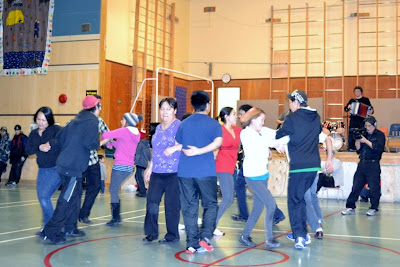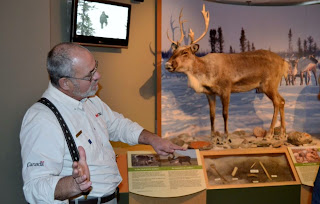March 9, 2013 Beautiful, clear day. Almost calm. -44C but feels warmer.
Today was move day for a co-worker and progressed well, Nunavut style – skidoo and a qamutiq.
As the weather improves, I need to start work on my on readying my qamtiq and snow machine for weekend exploring.
February 26 - 28, 2013 Participated in the Circumpolar Workshop on Human-Polar Bear Conflict Reduction and Mitigation, Framsenteret, Tromsø, Norway.
http://awsassets.wwf.no/downloads/program___2013_human_polar_bear_conflict_reduction_workshop_1.pdf
http://wwf.panda.org/what_we_do/where_we_work/arctic/wildlife/polar_bear/year_of_the_polar_bear/?207727/Increasing-bearhuman-conflict-needs-government-intervention-say-experts
This was an incredible opportunity to exchange useful knowledge and ideas from people across the circumpolar range of polar bears. Fascinating group of people from polar bear monitors, biologists, WWF, COS and policy makers. Connections were made to pursue initiatives range states wide.
The city of Tromso is beautiful, situated on the ocean and nestled in mountains. The sense you get is that the people of Tromso are very into the outdoors. There are only 2 TV channels and one seemed to be almost dedicated to x-country ski racing. Check out the pictures.
.jpg) |
| Photo by Tine Marie Hagelin, WWF, Norway |
 There were a couple of evenings at the Bla Rock Pub which, while small in size it boasted engagements with many well known groups like the Pogues. Great rock and roll decor and Tromso's best burgers.
There were a couple of evenings at the Bla Rock Pub which, while small in size it boasted engagements with many well known groups like the Pogues. Great rock and roll decor and Tromso's best burgers.
Just before leaving for Tromso, Igloolik held their belated “Return of the Sun Festival”. This picture was from the first day we see the sun. It had been coming over the horizon for a few days but was obscured by ice fog until this day. The tradition is that as soon as you see it for the 1st time you have to smile at it with half your mouth. I'm still searching for the story that goes with practice. The consequences of not doing this are supposed to be dire.
The start was the ceremonial lighting of the kudlik or seal oil lamp. At a gathering at the school gym an elder lit the lamp using a container of fluff from birch catkins with a flint and steel.
The fire is then passed on from lamp to lamp and traditionally from igloo to igloo. From that point on there was storytelling by elders followed by drum dancing.The traditional container for the fire starter material used to a small bowl made from sewn ducks feet.
The next night of the festival was dance night. There was a very talented 16 year old Igloolik accordian musician who together with another fellow on guitar really got the crowd going. The square dancing had gone on uninterrupted for almost an hour when I left.
I left the gym and headed over to 2 connected igloos that had been built for the festival by the school. Elders had set up the igloos as they would be for a trip on the land, complete with a sleeping platform covered with caribou skins, a lit kudlik (oil lamp), coleman stove, pilot biscuits, ulu, knives, etc. The invite was made for people to spend the night. As far as I know I was the only one to take advantage. The wind was howling and the temperature cold (-47C) when I headed over with my gear. The lit kudlik had the igloo at a comfortable temperature. Despite the wind outside I had a comfortable night.Very memorable experience.


January 23, 2013 Clear night, almost full moon, 24 kmph NW, -34C drifting snow and I’m approaching the end of my first year in Igloolik.
All of a sudden it's 2013. Just back from a month on the coast. Was great to be back on the lush West Coast with family and friends to celebrate Adrienne's birthday, Christmas and New Years.
Even made it up to Mt Washington on a spectacular day.

On returning to Igloolik there were still some people with decorations up. This pic is shows my favorite Igloolik Christmas lights.

My first lunch back at the research center there was a surprise visitor. This bear is 10 feet long and will visiting schools.
I arrived back in Igloolik in time to meet Joel Heath the researcher and maker of the important and beautiful documentary People of the Feather. We're heading out the high school in a bit of storm for Joel to show the film. He is wearing a traditional parka made of eider duck skins. Be sure to check out the documentary if you get a chance. Igloolik was the first stop of an eastern Arctic tour.
Chloe wore a bird themed hat to the showing.
December 6th, 2012. Day before heading to the coast was a bit of mad rushing. October and November were busy for bears on Igloolik Island. The polar bears were very active on Igloolik Island even to the extent of walking through town.
The GN hired a polar bear monitor and Jimmy and I spent many weeks on standby for the evenings and weekends while Jerry patrolled extensively from early morning to late afternoon. Introduced some residents to some means of deterrence.


Some bears met their end after repeatedly returning to the town area. When a bear is shot it is skinned out very quickly before it freezes. After the skinning the meat is also quickly apportioned out for human consumption and/or for feeding dog teams. A half hour later there is just a patch of disturbed snow.
In early October a large extent of sea ice to the north of us broke free. The winds blew hard from the NW for almost 2 weeks and eventually the huge expanse of ice came to rest up against the shore of Igloolik Island.
On a patrol out to Igloolik Point, Theo, the CO pointed at the ice and stated "You know there could be 50 bears on that ice".
A few days later we had a bear complaint from that area. Theo and Jimmy were responding to a bear call a couple of weeks later along the same shoreline. They located the bear in question and chased it away from a cabin with 12 gauge bangers. After firing they looked out at the jumbled, heaved up, broken sea ice and saw one bear after another stick their head up to check out the noise - 8 different bears in all.
Right up to Feb 4th the bear activity continued off and on. Now it is expected that most bears are out on the winter expanse of sea ice hunting their primary prey, seals.
Thanksgiving in Churchill, Manitoba
In October I travelled to Churchill as part of an international committee working on reducing polar-bear human conflicts. Churchill has a remarkable history when it comes to bears and people. Every year many bears, like up to several hundred, end up on the last remnants of sea ice as the spring thaw progresses in Western Hudson Bay.
Eventually they end up on land in the Churchill area.
One of the reasons for holding the workshop in Churchill was to see the scene first hand from ecotourism, Manitoba's Polar Bear Alert Program, the measures the community has taken, some of Parks Canada's operation, the Churchill Science Center and the education/outreach that is going on. Fascinating and educational experience overall. We also progressed further towards implementation of a common database for collecting, managing and analyzing information across the polar bear range states from Alaska to Greenland to Russia.
The last day was a field day to experience first hand the tundra buggy operation.
Here's one of the local summer/fall residents relaxing as spotted from a tundra buggy. The bear looks close due to my telephoto. We were about 100 meters away.

Another resident I wasn't expecting to see was this fox.
The Churchill Science Center is where we stayed and held our meetings. The center has existed for many years and is next to the old Churchill Rocket Launch Area.
A new CSC was completed recently. Reminded me a bit of the Bamfield Marine Science Center.
Churchill is well known for great northern lights. The new center actually has a spiral staircase up into a Plexiglas bubble on the roof. It provides a 360 degree view of the night sky and on one night a great display of northern lights.
 |
| Photo by Angie Southwold, Alaska F&W |
The Wapusk NP interpretive center is very impressive. This fellow was a gifted storyteller.
One of our working group is a Regional Manager with the Manitoba COS, who has a 20+ plus year history with the well-known Churchill Polar Bear Alert Program. He has been involved with shaping that program which is very impressive. Teams of COs maintain 24/7 coverage in the community for the duration of the bear season every year. Bears that come into town are carefully pushed out. Bears that return repeatedly can end up in the renowned bearholding facility. This intensive program together with closing the dump and other waste management measures has greatly reduced the mortality from conflict.
Bears in the area spend most of their time ashore fasting awaiting freeze up. If they end up in the holding facility disturbance is kept to a minimum. Some of the units have air-conditioning to keep the bears cool. When the timing is good they are tranquilized and flown well away from the community and released. Ideally it is close to freeze up when the urge is to head northward and out onto new ice in search of seals.
Our Polar Bear-Human Information Management System working group with representatives from Alaska, Nunavut, Manitoba, Parks Canada, Environment Canada, Greenland, Norway and WWF. At our most recent workshop in Norway there were also representatives from Svalbard and Russia.






.jpg)
.jpg)















Ice Hawg!
ReplyDeleteI thought perhaps a bear had gotten you, you hadn't posted for so long! Glad to see you are still kicking and visiting the family - and Norway.
-44 sounds a bit on the nippy side, as I sit on the side of Lake Mead where the temp (in the sun) is a balmy +30C.
But, I got a job with Alberta Forestry - Fire Control for the summer, so I will have to return to cool Alberta before all the white is gone. Good to hear your tales again.
Heh Ivan. Will have to call you the Desert Dawg. Way to go. Sounds like you have a prime spot there and an interesting summer ahead. Looking forward to your facebook updates. -51C today. Cold but beautiful up here.
DeleteHawg